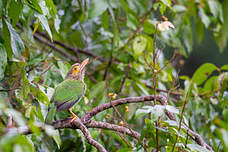Brown-headed Barbet
Psilopogon zeylanicus - Barbu à tête brune
Identification
The Brown-headed Barbet is a medium-sized bird, with a large head and a large, strong beak of light red color, in the breeding season the beak becomes a light orange color, small grayish feathers similar to hairs stand out at the base of the beak. As its name indicates, the head is light brown with whitish stripes, large black eyes framed by a thick yellow line. The brown color lightens at the back of the nape, the mantle and back are green. The scapulars are also green and dotted with small white spots. The tail is green, the belly is light green, the chest and throat take up the brown color and white stripes of the head; the legs of the Brown-headed Barbet are yellow.
There is no dimorphism between the male and female birds. Young birds have a duller plumage.
Subspecific information 3 subspecies
- Psilopogon zeylanicus zeylanicus (s India and Sri Lanka)
- Psilopogon zeylanicus inornatus (w India)
- Psilopogon zeylanicus caniceps (Nepal to c India)
Foreign names
- Barbu à tête brune,
- Barbudo cabecipardo,
- barbichas-de-cabeça-castanha,
- Braunkopf-Bartvogel,
- Bruinkopbaardvogel,
- Barbetto testabruna,
- brunhuvad barbett,
- Brunhodeskjeggfugl,
- barbet červenozobý,
- vousák hnědohlavý,
- Brunhovedet Skægfugl,
- rusohuppuseppä,
- barbut verd de l'Índia,
- pstrogłów nakrapiany,
- Цейлонский бородастик,
- ミドリオオゴシキドリ,
- 棕头绿拟啄木鸟,
- brunhuvad barbett,
- 斑頭綠擬啄木,
Voice song and call
Habitat
Behaviour character trait
Dietfeeding habits
The Brown-headed Barbet mostly feeds on fruits, particularly those from the Ficus Bengalensis, but can also turn to orchards, gardens. It can be spotted in coffee plantations and opinions differ: it likes the fruits of coffee trees, but according to recent studies, it could also attack the Xylotrechus quadripes insect (nicknamed the coffee pest in India) and its diet could extend to various insects, larvae and termites.
Reproduction nesting
Geographic range
Present throughout India, southern Nepal, and Sri Lanka, three races or subspecies are officially recognized:
M. z. caniceps-(southwest Nepal and northern India (Punjab and Uttar Pradesh, heading south to Maharashtra, Orissa, and Bihar)).
M. z. inornata-(central-western and southwestern India (Maharashtra, Goa, and Karnataka)).
M. z. zeylanica, the nominate race-(south India (Kerala, southern Tamil Nadu) and Sri Lanka).
Threats - protection
Sources of information
- IOC World Bird List (v14.2), Gill, F and D Donsker (Eds). 2024-04-18.
- Avibase, Lepage Denis
- Vol. 7 - Handbook of the Birds of the World, Josep del Hoyo-Andrew Elliott-Jordi Sargatal
- A Photographic GUIDE TO THE BIRDS OF INDIA, Bikran Grewal, Bill Harvey, Otto Pfister
- A Field Guide to the Birds of the Indian Subcontinent, Krys Kazmierczak, Ber Van Perlo
Other sources of interest
 Specification sheet created on
02/08/2023 by Anne et Gabriel Leboff
Specification sheet created on
02/08/2023 by Anne et Gabriel LeboffTranslation by AI Oiseaux.net
© 1996-2025 Oiseaux.net
- Accipitriformes
- Aegotheliformes
- Anseriformes
- Apodiformes
- Apterygiformes
- Bucerotiformes
- Caprimulgiformes
- Cariamiformes
- Casuariiformes
- Charadriiformes
- Ciconiiformes
- Coliiformes
- Columbiformes
- Coraciiformes
- Cuculiformes
- Eurypygiformes
- Falconiformes
- Galliformes
- Gaviiformes
- Gruiformes
- Leptosomiformes
- Mesitornithiformes
- Musophagiformes
- Nyctibiiformes
- Opisthocomiformes
- Otidiformes
- Passeriformes
- Pelecaniformes
- Phaethontiformes
- Phoenicopteriformes
- Piciformes
- Podargiformes
- Podicipediformes
- Procellariiformes
- Psittaciformes
- Pterocliformes
- Rheiformes
- Sphenisciformes
- Steatornithiformes
- Strigiformes
- Struthioniformes
- Suliformes
- Tinamiformes
- Trogoniformes





























